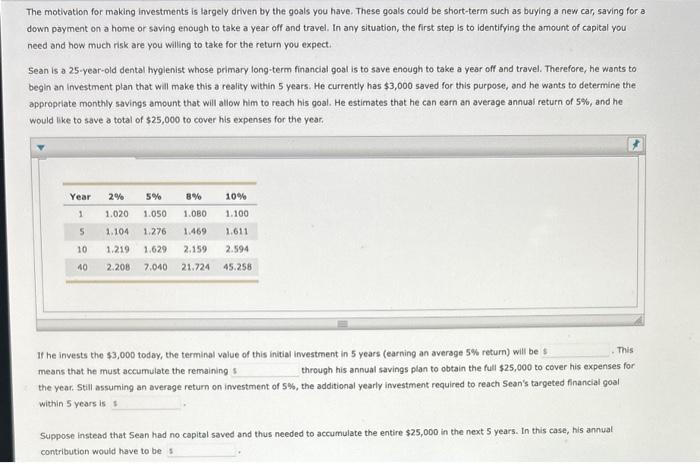The motivation for making investments is largely driven by the goals you have. These goals could be short-term such as buying a new car, saving for a down payment on a home or saving enough to take a year off and travel. In any situation, the first step is to identifying the amount of capital you need and how much risk are you willing to take for the return you expect. Sean is a 25-year-old dental hyglenist whose primary long-term financial goal is to save enough to take a year off and travel. Therefore, he wants to begin an Investment plan that will make this a reality within 5 years. He currently has $3,000 saved for this purpose, and he wants to determine the appropriate monthly savings amount that will allow him to reach his goal. He estimates that he can earn an average annual return of 5%, and he would like to save a total of $25,000 to cover his expenses for the year. If he invests the $3,000 today, the terminal value of this initial imvestment in 5 years (earning an average 5% return) will be This means that he must accumulate the remaining through his annual savings plan to obtain the full $25,000 to cover his expenses for the year. Still assuming an average return on investment of 5%, the additional yearly investment required to reach Sean's targeted financial goal within 5 years is Suppose instead that Sean had no capital saved and thus needed to accumulate the entire $25,000 in the next 5 year5. In this case, his annual contribution would have to be Suppose instesd thet Sean had no capital saved and thus needed to accumulate the entire 575,000 in the next 5 years. In this case, his annual contribution would heve to be When Sean starto with an intial investment of $3,000, the total amount that he ends up contributing to accumulate $25,000 is equal to the initial iewestment plut the bddisional yearly peyments, for a tocal of . When he starts with no inital capieal contrioution, the amount he ends up comtributing is equal to the sum of all annual contributions you caiculated in the no-inita-cagital scenario, for a total of Once Sean has determined the annubl amourit he needs to srve, the next step toward achieving his goal is coming up with an investment plan. Thu or Falber The appropriete investment pien depends orily on the total amount of money he intends to save, not on the investment objective. True Valse








